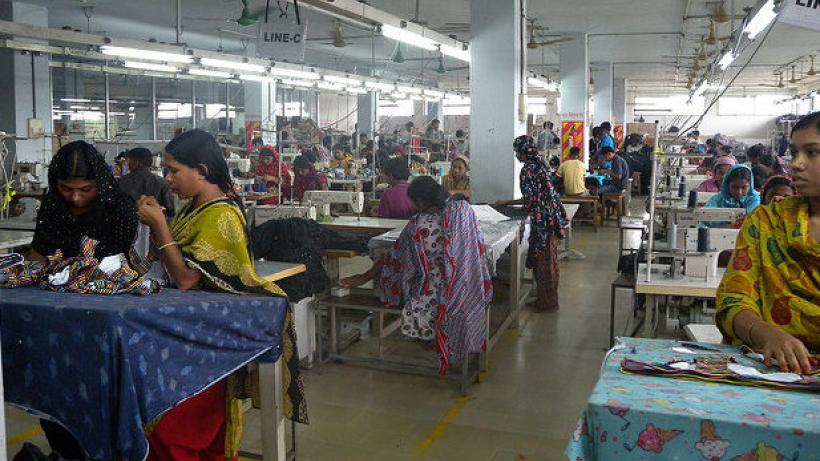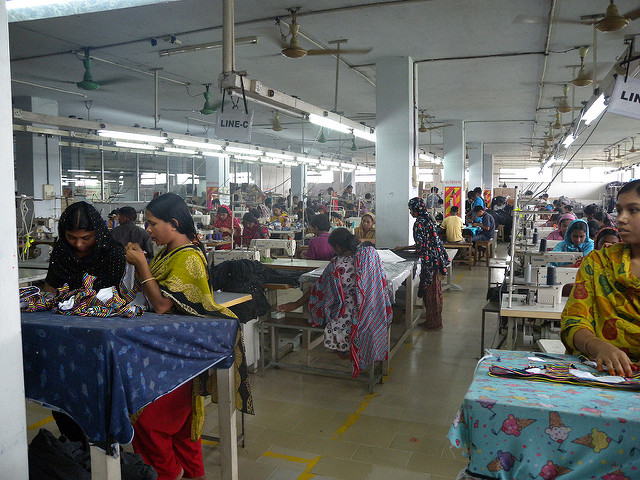
Real effects of electronic wage payments: Bangladeshi factory workers
Electronic wage payments offer an alternative to traditional financial inclusion approaches for the un-banked. Addressing constraints to savings can allow wages and remittance flows to poor households to translate into greater asset accumulation and resilience to financial or consumption shock.
More than two billion people around the world do not have access to electronic financial systems (Demirguc-Kunt et al., 2017). These adults - most of them poor - rely on cash to manage their day-to-day finances and plan for the future. Cash-only transactions with governments, banks and other institutions lead to high transaction costs, losses due to corruption, and a widening of the gap between formal and informal financial systems.

Bangladeshi factory
Image credit: Tareq Salahuddin
Electronic payments and remittances can reduce income inequality, boost job creation, accelerate consumption, increase investments in human capital, and directly help poor people manage risk and absorb financial shocks. A study on Bangladeshi garment factory workers reveals the impact of electronic wage payments (EWPs) on savings, asset accumulation and responding to financial shocks, while revealing key barriers to the market providing EWP services.
Electronic payments and remittances can reduce income inequality, boost job creation, accelerate consumption, increase investments in human capital, and directly help poor people manage risk and absorb financial shocks.
The benefits of an electronic economy
Policymakers around the world view the migration of poor households to EWPs as an essential ingredient in expanding financial inclusion. An electronic economy has the potential to dramatically reduce costs, increase efficiency and transparency, help build infrastructure, and broaden familiarity with electronic payments.
There are considerable benefits when governments shift their social, salary, and procurement payments, and taxation and licensing receipts to electronic form. It creates a foundation upon which the private sector and person-to-person payments, such as international and domestic remittances, can build.
Many governments have begun to experiment with the use of electronic payment technologies. For example, as a way to channel welfare payments to low-income individuals. Colombia’s Familias en Accion Programme, and Pakistan’s Benazir Income Support Scheme, are two examples welfare programmes that operate entirely through electronic payments.
Formal bank accounts: Opportunities and barriers
Electronic payments may also provide a solution to another pervasive problem in developing countries: the underutilisation of formal accounts. Electronic payments are often the first entry point into the financial system for individuals. They provide an opportunity to create traditional formal bank accounts or mobile phone accounts for savings or payments.
While many countries have aggressively expanded their banking infrastructure, poor households often still choose to save using informal methods. Many formal accounts remain dormant, resulting in their potential welfare benefits not being realised. Demirguc-Kunt et al. (2017), show that, while 50% of adults have a formal bank account, only 43% report making a deposit during the previous 12 months. Moreover, only 21% of adults globally and 7% of adults in South Asia report using their account to receive regular wage or welfare payments.
Electronic payments and welfare
Despite the assumed importance of modern payment technologies for low income populations, there currently exists little empirical evidence on the welfare benefits of electronic payments. Notable exceptions are studies of M-Pesa in Kenya, which has achieved unprecedented success in providing mobile payment services to over 80% of Kenyan households. Results from this line of research suggest that electronic payments may have significant welfare benefits, as they reduce transaction costs and allow for improved consumption smoothing. Mobile-phone based accounts are used to make transfers to individuals affected by economic shocks, and mobile payments help people receive assistance from a geographically wider network of relatives and friends (Jack and Suri, 2014; Blumenstock et al., 2016).
Mobile-phone based accounts are used to make transfers to individuals affected by economic shocks, and mobile payments help people receive assistance from a geographically wider network of relatives and friends.
Study: Salaried factory workers in Bangladesh
To study these issues, a randomised controlled trial was conducted on salaried factory workers in Bangladesh. It involved two large garment factories which, at the beginning of the study, were paid all their wages in cash. Workers were then randomly and individually assigned within the same factory to either continue receiving their wages in cash, or receive EWPs through either a bank or mobile account.
In two additional treatment arms, bank and mobile money accounts were given with no EWPS. Workers were followed over approximately two years to measure the effect of EWPs on savings, asset accumulation, and the ability to cope with financial shocks.
Key results
Preliminary results suggest that the treatments stimulated the use of formal financial products, with a detectable increase in savings in both bank treatments. The extensive margin response of bank EWP is particularly strong. Changes were also observed in the composition of savings in the two bank treatments.
In contrast, the mobile money treatments did not have very strong long-run impacts on total savings accumulation. This is consistent with the typical usage patterns of mobile money accounts, and a low incidence of savings accumulation in the mobile wallet.
Moreover, there is evidence that EWPs likely did help workers better respond to shocks, especially in the mobile EWP treatment. All treatments appeared to increase trust in financial intermediaries, especially mobile money platforms.
Electronic wage payments: Key barriers
One lingering question is, given the average benefits of EWPS and the costs of cash for the factories, why hasn’t the market stepped up to expand the scale of EWP services? The study exposed several key barriers at play:
- Factories fear resistance by workers. Workers may be nervous at the prospect of changing their method of payment. However, the results suggest that workers not only learned how to use their accounts and adjusted to the new system, but preferred EWPs.
- Insufficient identification documentation (ID). Many workers do not have national ID cards, and among those who do, there are many mistakes in the information printed on the cards. This makes it hard to satisfy the “know your client” (KYC) requirements imposed by the central bank. Moreover, any changes in national regulatory banking requirements, put the implementation of EWPs at risk. For example, during the project implementation, Bangladesh Bank changed the documentation requirements five times.
- Firms fear the costs of upkeep of an EWP system. Troubleshooting is essential to keep payroll accounts operational. For example, ATM cards may be lost or captured by ATM machines, and workers may lose their SIM cards, resulting in a loss of access to their mobile money accounts. The results show that when implementation works well, trust in the financial system improves. However, botched implementation can easily have the exact opposite result.

